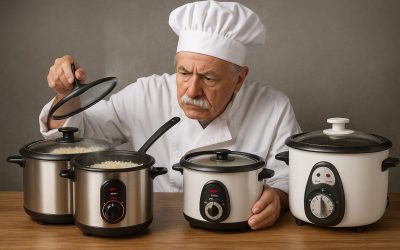Uncover the essential tools for cleaning and maintaining a rice cooker after use, ensuring its longevity and performance. Learn the best care practices.
As an Amazon Associate I earn from qualifying purchases.
As the saying goes, “A well-maintained tool is a happy tool,” and this sentiment holds just as true for your rice cooker as it does for any other appliance in your home. While a rice cooker serves as a reliable ally in delivering perfect, fluffy grains each time, the true mark of culinary wisdom extends beyond cooking. It lies in the often-overlooked art of post-cooking care—cleaning and maintenance. Like any kitchen appliance, a rice cooker requires regular upkeep to function at its best, prolong its lifespan, and ensure that each cup of rice it produces meets your quality standards. However, proper cleaning and maintenance are not as simple as just a rinse and a scrub. Specific tools, when employed correctly, can make this process more efficient, effective, and, dare we say, enjoyable. In this article, we will explore the indispensable tools and best practices to keep your rice cooker in pristine condition, ensuring that this culinary workhorse stays effective for years to come.
Most Recommended Cleaner for Cookware
———
Table of Contents
———
…
What Are the Essential Tools for Cleaning and Maintaining a Rice Cooker after Use
Maintaining and cleaning a rice cooker properly can extend its lifespan and keep your rice tasting fresh. Here are some essential tools and their corresponding roles in the cleaning and maintenance process:
Essential Tools for Cleaning
- Soft Sponge or Cloth: A non-abrasive sponge or cloth is ideal for cleaning the inner pot, especially if it has a non-stick surface, as metal scrubbers can cause scratches and reduce its lifespan.
- Mild Dish Soap: A small amount of gentle dish soap can help remove oily or sticky residues. Always rinse thoroughly.
- Soft-Bristle Brush: Use this for nooks and crannies where rice or residue may accumulate, like the steam vent or any buttons. Ensure that it is soft enough not to scratch any surfaces.
- Damp Cloth: A separate damp cloth is useful for wiping down the exterior of the rice cooker and its lid. Avoid using any cleaning agents that could be abrasive or corrosive.
- Dry Towel or Cloth: After cleaning, it’s essential to thoroughly dry all components before reassembling and storing the rice cooker.
Essential Tools for Maintenance
- White Vinegar or Lemon Juice: These natural acids can help decalcify the heating element if you have hard water. Just fill the inner pot with water and add a cup of white vinegar or lemon juice, then run a standard cooking cycle without rice. Remember to rinse thoroughly afterward.
- Q-Tips or Cotton Balls: For areas that are challenging to reach, such as small vents or corners, a Q-tip or cotton ball can be effective. Be careful not to let any cotton get stuck in the vents.
- Food-Safe Lubricant: Over time, any moving parts like hinges or latches might need lubrication. Ensure any lubricant used is food-safe.
Tips for Effective Cleaning and Maintenance
- Regular Checks: Always inspect for food particles or residues after each use to prevent buildup and bacterial growth.
- Don’t Immerse: Never immerse the main unit with electrical components in water.
- Read the Manual: Always consult your user manual for any specific cleaning and maintenance tips for your model, as some may have unique requirements.
- Periodic Deep Cleaning: In addition to regular cleaning, consider deep cleaning the unit every few months, especially if you use it frequently.
- Check Seals and Gaskets: Periodically inspect any seals or gaskets to ensure they are intact. Damaged or degraded seals can affect the cooking performance and may need replacement.
By utilizing these essential tools and tips, you can ensure that your rice cooker stays in optimal condition for years to come.
Frequently Asked Questions (FAQ’s)
Here are some common questions and answers about essential tools for cleaning and maintaining a rice cooker after use:
Q: What tools do I need to clean a rice cooker after use?
A: Cleaning a rice cooker typically requires a soft sponge or cloth, mild dish soap, water, a non-abrasive scrubber, and a small brush for hard-to-reach areas.
Q: Can I use abrasive scrubbers or steel wool to clean my rice cooker?
A: It’s not recommended to use abrasive scrubbers or steel wool, as they can damage the non-stick coating of the rice cooker’s inner pot. Stick to soft sponges or non-abrasive scrubbers.
Q: Do I need a special cleaning solution for my rice cooker?
A: Usually, mild dish soap and water are sufficient for cleaning the rice cooker. Avoid harsh chemicals that could damage the rice cooker’s surfaces.
Q: Can I wash the inner pot in the dishwasher?
A: Check the manufacturer’s instructions for your specific rice cooker model. While some inner pots are dishwasher-safe, it’s often safer to hand wash them to prolong their non-stick coating.
Q: Do I need a special brush to clean hard-to-reach areas?
A: While not strictly necessary, a small brush with soft bristles can be helpful for cleaning crevices and tight spaces in the rice cooker, such as around the heating element or inside the lid.
Q: How do I remove stubborn food residue from the inner pot?
A: For stubborn residue, create a mixture of water and baking soda to form a paste. Apply this paste to the residue, let it sit for a while, then gently scrub it away with a soft sponge.
Q: Can I clean the exterior of the rice cooker with the same tools?
A: Yes, you can use the same tools to clean the exterior of the rice cooker. Wipe down the exterior with a damp cloth and mild dish soap. Avoid getting water into the electrical components.
Q: Is vinegar safe to use for cleaning a rice cooker?
A: While vinegar can be effective for removing mineral deposits, it’s important to use it with caution. Consult your rice cooker’s manual to see if using vinegar is recommended, as it could affect the cooker’s non-stick coating or other components.
Q: How often should I clean my rice cooker?
A: It’s best to clean your rice cooker after every use to prevent food residue from building up. Regular cleaning helps maintain the appliance’s performance and extends its lifespan.
Q: Can I use a hairdryer or compressed air to dry the rice cooker?
A: It’s safer to let the rice cooker air dry or gently pat it dry with a cloth. Using a hairdryer or compressed air could introduce moisture to electrical components, leading to damage.
Properly cleaning and maintaining your rice cooker not only ensures the longevity of the appliance but also contributes to the quality and safety of your cooking. Always refer to the manufacturer’s instructions for specific cleaning guidelines for your rice cooker model.
Conclusion
Navigating through the culinary journey of cooking rice is only part of the story. As we’ve emphasized throughout this article, the longevity and efficacy of your rice cooker depend just as much on after-care as they do on the cooking process itself. From the non-abrasive sponge designed to protect the delicate non-stick coating, to the food-safe lubricants that keep moving parts operating smoothly, each tool serves a critical role in maintaining your appliance.
The process of cleaning and maintenance may seem trivial, but when carried out consistently and properly, it has a profound impact on the quality of your meals and the life of your rice cooker. Having a dedicated set of tools for this purpose ensures that you’re not just reacting to problems as they occur, but proactively preserving the condition of your appliance. In essence, these tools aren’t just tools; they’re investments in the longevity and performance of your rice cooker.
So the next time you savor that perfectly cooked grain of rice, take a moment to acknowledge the backstage crew—the cleaning and maintenance tools—that help make each culinary performance a resounding success. These are your unsung heroes, deserving of as much attention and care as the rice cooker itself. After all, what’s a great tool without great upkeep? Happy cooking, and even happier cleaning!







